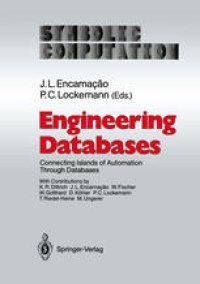
Ebook: Engineering Databases: Connecting Islands of Automation Through Databases
- Tags: Database Management, Information Systems Applications (incl. Internet), Software Engineering, Electronics and Microelectronics Instrumentation, Models and Principles, Control Robotics Mechatronics
- Series: Symbolic Computation
- Year: 1990
- Publisher: Springer-Verlag Berlin Heidelberg
- Edition: 1
- Language: English
- pdf
Automation is nothing new to industry. It has a long tradition on the factory floor, where its constant objective has been to increase the productivity of manufacturing processes. Only with the advent of computers could the focus of automation widen to include administrative and information-handling tasks. More recently, automation has been extended to the more intellectual tasks of production planning and control, material and resource planning, engineering design, and quality control. New challenges arise in the form of flexible manu facturing, assembly automation, and automated floor vehicles, to name just a few. The sheer complexity of the problems as well as the state of the art has led scientists and engineers to concentrate on issues that could easily be isolated. For example, it was much simpler to build CAD systems whose sole objective was to ease the task of drawing, rather than to worry at the same time about how the design results could be interfaced with the manufacturing or assembly processes. It was less problematic to gather statistics from quality control and to print reports than to react immediately to first hints of irregularities by inter facing with the designers or manufacturing control, or, even better, by auto matically diagnosing the causes from the design and planning data. A heav- though perhaps unavoidable - price must today be paid whenever one tries to assemble these isolated solutions into a larger, integrated system.
This book discusses the maturity of today's database technology in the light of the needs of engineering applications and industrial automation. Those at the forefront of database research come up with new techniques to satisfy new needs, but today's engineering community must live with database systems that reflect the older state of the art. The purpose of the book is to demonstrate that even though solutions based on today's technology are less than perfect, they do provide solutions to current pressing problems. The book mainly covers current database technology and its applications, but also mentions some promising techniques under research in order to prepare the reader for the future. The book contains four chapters that cover the significance of engineering databases, the current state of database technology, the utilization of engineering databases, and two extensive case studies. For cursory reading, the chapters may be considered to be self-contained. Intended readers are middle management and engineers from industry who deal with automation both as users and vendors, consultants to such industry, vendors of database systems, and lecturers and students. The book requires no special background in informatics.
This book discusses the maturity of today's database technology in the light of the needs of engineering applications and industrial automation. Those at the forefront of database research come up with new techniques to satisfy new needs, but today's engineering community must live with database systems that reflect the older state of the art. The purpose of the book is to demonstrate that even though solutions based on today's technology are less than perfect, they do provide solutions to current pressing problems. The book mainly covers current database technology and its applications, but also mentions some promising techniques under research in order to prepare the reader for the future. The book contains four chapters that cover the significance of engineering databases, the current state of database technology, the utilization of engineering databases, and two extensive case studies. For cursory reading, the chapters may be considered to be self-contained. Intended readers are middle management and engineers from industry who deal with automation both as users and vendors, consultants to such industry, vendors of database systems, and lecturers and students. The book requires no special background in informatics.
Content:
Front Matter....Pages I-XII
Significance of Engineering Databases....Pages 1-19
Database Technology....Pages 21-137
Utilization of Engineering Databases....Pages 139-188
Case Studies....Pages 189-229
This book discusses the maturity of today's database technology in the light of the needs of engineering applications and industrial automation. Those at the forefront of database research come up with new techniques to satisfy new needs, but today's engineering community must live with database systems that reflect the older state of the art. The purpose of the book is to demonstrate that even though solutions based on today's technology are less than perfect, they do provide solutions to current pressing problems. The book mainly covers current database technology and its applications, but also mentions some promising techniques under research in order to prepare the reader for the future. The book contains four chapters that cover the significance of engineering databases, the current state of database technology, the utilization of engineering databases, and two extensive case studies. For cursory reading, the chapters may be considered to be self-contained. Intended readers are middle management and engineers from industry who deal with automation both as users and vendors, consultants to such industry, vendors of database systems, and lecturers and students. The book requires no special background in informatics.
Content:
Front Matter....Pages I-XII
Significance of Engineering Databases....Pages 1-19
Database Technology....Pages 21-137
Utilization of Engineering Databases....Pages 139-188
Case Studies....Pages 189-229
....